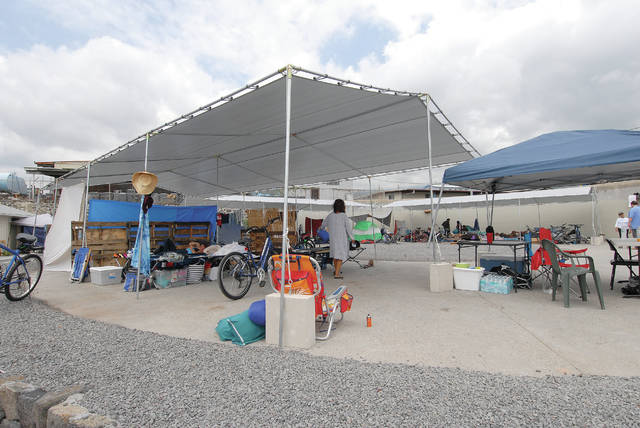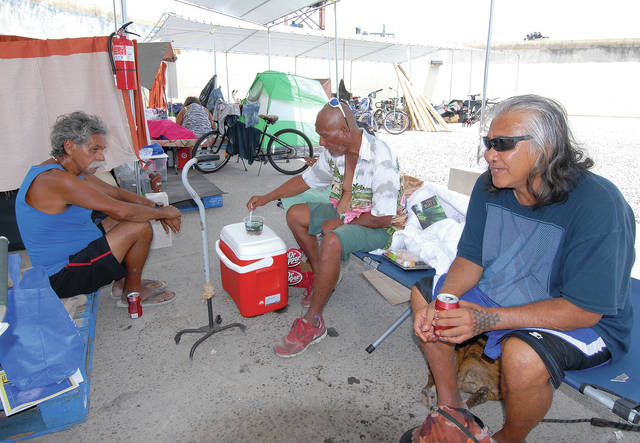KAILUA-KONA — Hawaii County continues to move forward with plans to relocate Camp Kikaha out of the Old Kona Industrial Area and expand it to accommodate several hundred homeless on a permanent basis — but both the process and pace of that change have been altered in recent weeks.
Initially, the county’s plan was to access 5 acres of a 35-acre parcel mauka of Queen Kaahumanu Highway and south of Kealakehe Parkway by way of a temporary right of entry permit. Roy Takemoto, executive assistant to Mayor Harry Kim, said doing so would have allowed for a more immediate relocation of some of Kona’s homeless, around 100 individuals, because of an environmental assessment requirement exemption that might accompany the permit.
That path was scrapped for two reasons, Takemoto said. The first was that Gov. David Ige was not willing to renew an emergency proclamation concerning homelessness he made in late 2015, which would have eased the way.
The second involved affording North Kona residents more say in the process by conducting an EA before moving any homeless to the area, even to a temporary site situated on 5 acres. An EA for the larger, permanent site was always part of the county’s plan.
“We thought we needed to give the community a fair chance to voice opinions on the location, and the environmental assessment is a means to do that,” Takemoto explained.
The new route to construction of a permanent homeless site, replete with fully functional living spaces and social services, involves Hawaii County negotiating a memorandum of understanding with the Hawaii Housing Finance and Development Corporation, which owns the parcel in question, listed on maps as Village 9.
Village 9 is home to about 30 acres of land suitable for development, the other 5 acres designated as a critical habitat. The county will lease 15 acres for its homeless project from the HHFDC, while the HHFDC will utilize the rest for a low-income housing project.
Under the ongoing negotiations, HHFDC would assume the cost of a master plan and an EA for the entire 30 acres, something Takemoto said was a necessity to make the project financially feasible for the county.
Kent Miyasaki, state housing information specialist, said the matter is likely to be decided at the next HHFDC Board meeting, scheduled for Jan. 11.
“I don’t see any opposition to approving it,” he said. “We’ve been discussing it for (several months).”
Takemoto said the county’s cost projections are around $160,000, according to a proposal from a consultant working on a separate EA for the proposed Kealakehe Regional Park, to be situated adjacent to the joint county/HHFDC housing development.
The original plan might have seen temporary igloo structures, to precede more permanent housing, filled by homeless as early as February or March. Assuming board approval of funding for the revised project, the master plan will likely require three months for development. Takemoto guessed the EA process as taking around another four months after that.
“Assuming everything goes well, we wouldn’t be able to do any site work until later summer,” he said.
As to whether Camp Kikaha can sustain itself that long, Linda Vandervoort, volunteer camp administrator, said she believes it can.
The open-air encampment currently supports 20 homeless individuals. That number had been as high as the low 30s in the weeks immediately following the mass homeless exodus from Old Kona Airport Park, which saw dozens of homeless evicted from tent cities at the behest of the mayor.
Vandervoort said a few unruly homeless were ultimately forced to leave the camp but after some hiccups, most adjusted. Since the camp took shape in August, 10 homeless people have moved on to emergency housing next door at HOPE Services Hawaii. Some of them have moved onward in the process toward permanent housing, while two of the 10 have already been placed in permanent homes.
Camp Kikaha is not accepting any new tenants, Vandervoort explained.
“I feel right now, with the amount of funding I’m allotted and the resources we have, 20 is the magic number to work with,” she said.
The county canceled its security contract with RMT Enterprises Security Division for Camp Kikaha near the end of October, the same time it canceled the company’s security patrols at Old A., Vandervoort said. The county cited cost as the primary factor.
Vandervoort added that before the cancellation came about, security was phased back and the campers were made accountable to police themselves, at least in part.
Under her supervision, and with more or less daily visits from the Hawaii Police Department’s Community Policing section, the homeless still residing there have managed and comported themselves well, she said.
“The people in the camp have become accustomed to what’s expected of them,” Vandervoort explained.





